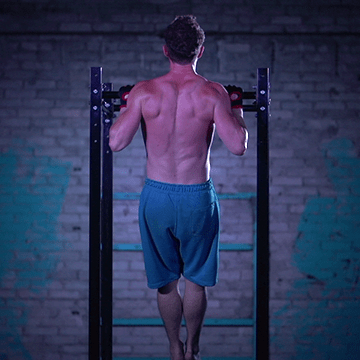You go to the gym, and you see people doing pull-ups on different bars with different grips, and you don’t know which one is the best for you.
With all of the different pull-up bars out there, it can be hard to figure out which grip is best for you. For example, should you do wide-grip pull-ups or close grip? Should you use an overhand grip or an underhand grip?
We have the answer. If your goal is to build muscle mass or improve your overall pulling strength with this amazing back builder exercise, then the best hand grip would depend on your current skill level, mobility, and specific goals. The effects on muscles SLIGHTLY vary to different types of grip width and grip orientation you perform. That is why it is important to utilize the grip that specifically targets your goal.
HOWEVER, for general strengthening and muscle-building purposes of the lattisimus dorsi (the major muscle we target during pull-ups) and other assisting pulling muscles ( middle traps, infraspinatus, biceps, etc), you can perform whichever hand orientation or grip type that’s comfortable for you to use. It’s also good to switch up the grip per training phase to include variety in your training sessions.
This article will discuss the different types of pull-up grips and which one is best for you based on your fitness goals. We will also answer common questions about pull-ups and different grips.
Here’s a short rundown on what to expect from the current scientific literature:
| GRIP ORIENTATION | INCREASE MUSCLE ACTIVATION |
| Pronated grip (overhand grip) | Lower trapezius
Insfrapinatus |
| Supinated grip (underhand grip) | Pectoralis major
Bicep brachii |
| Perfect pull-up ( 360-degree rotating grips similar to pull-ups done on gymnastics rings) | Latissimus dorsi |
| False grip | Flexors
Brachioradialis |
| GRIP WIDTH | PROs | CONs |
| Wide (wider than shoulder-width) |
|
|
| Narrow (Less than shoulder-width) |
|
|
| Medium (Shoulder-width) |
|
|
👉Take note that differences among muscle-activity elicited were not significant enough; hence, all pull-up variations can promote more or less similar adaptations.
This means that grip width and style can come down to PREFERENCE.
Pull-ups: The fundamental pulling exercise
If you want toi improve your pulling strength, build superior upper body muscles, and have healthier shoulder joints, then training the pull-up is key.
It’s a basic exercise, BUT still many people fail to do even just one rep. There’s no shame in that, but building strength toward pull-ups is a great way to improve your overall health. Taking the progressive approach of calisthenics helps you master the pull-up safely and efficiently as possible.
Read here: The Ultimate Guide to Pull-up Progressions
Aside from that, it’s worth noting that despite the different grip styles, pull-up variations follow more or less the same technique. Master the proper pull-up technique here: 11 Dumbest You Need to Avoid When Doing Pull-ups
What is a Pull-up Grip?
Pull-up hand position can be broken down into wide grip (wider than your shoulders), narrow grip (narrower than your shoulders), and somewhere in between. Pull-up hand position can also be defined in terms of overhand grip (pronated grip), underhand (supinated grip), and neutral grip (palms facing each other). In addition, there’s also the specialised false grip in which you’re gripping more of your palms rather than just covering the bar with your fingers.
A Pull-up grip is commonly used in gymnastics, calisthenics, weightlifting, and other sports. It is often used to help athletes perform pull-ups and other moves that require upper body strength.
Pull-up grip affects muscle activation. You will definitely feel the difference of each grip when you just even hang onto the bar, but the difference will more manifest once you perform a complete repetition of the pull-up.
Types of pull-up grip width
As mentioned above, there are different types of pull-up grips that you can use. These grips can be either wide, narrow, or in between (shoulder-width).
Wide pull-up grip
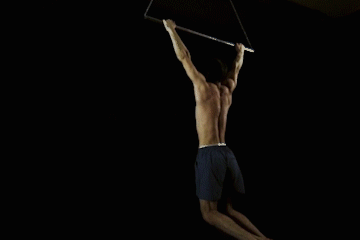
Wide Arm Pull-up
This grip variation is an effective bodyweight exercise for building upper-body strength. Wide grip pull-ups are essentially regular pull-ups with a wider hand position.
The benefits of wide-grip pull-ups are that they target the latissimus dorsi (lat) muscles more than other grips. The lats are a large muscle group extending from the lower back to the upper arm.
Wide grip pull-ups also help to build grip strength. The wider hand position puts more stress on the forearm and hand muscles.
To perform a wide grip, place your hands slightly wider than shoulder-width apart. Diminishing returns also manifest in a wide grip. A too wide stance would limit your range of motion so it’s best to keep it conservative.
Narrow pull-up grip
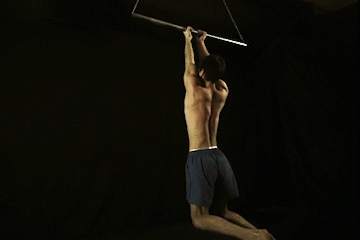
Narrow Pull-up grip
A Close-grip pull-up or the narrow pull-up grip is a great upper body exercise that develops the inner lats and strengthens the back, arms, and core muscles. In addition, close-grip pull-ups emphasize your biceps and chest muscles, making for better upper-body development exercises.
Close-grip pull-ups are also good exercises for developing grip strength. This is because the narrower hand position puts more stress on the forearm and hand muscles.
This grip can be limited by your forearm strength or wrist and shoulder mobility since it increases your elbow flexion.
You can perform the close grip conservatively by placing your hands close than shoulder width. You may also do it like in the gif above with your hands together.
In between pull-up grip
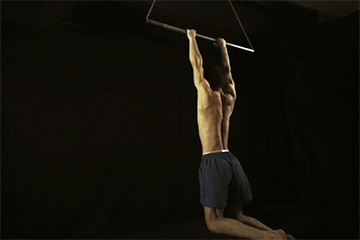
In between Pull-up grip
The in-between pull-up grip is just that, between the wide and close grip. It is a great exercise for developing upper body strength and can be used to target different muscle groups.
The in-between grip is often used by people because it offers a more “natural” position for the shoulders and usually optimal when performing pull-ups. But again, this is a case-to-case basis depending on your body proportions and muscle insertions.
Which one to use?
In practice, wide grip is usually used to further target the lats. Shoulder-width is the “basic” form while narrow can be used to involve the biceps and chest more.
HOWEVER, based on research, differences in muscle activation among grip-width are INSIGNIFICANT. This means that whether you choose a shoulder-width, narrow, or wide grip, strength and muscular adaptations will be the same.
Choose the grip width in which you are most comfortable. The best one should help you exert the most effort while not feeling any pain or restrictions in the process.
Type of grip orientation
Underhand (supinated) grip
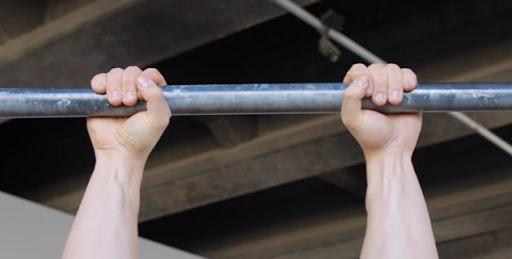
Overhand grip
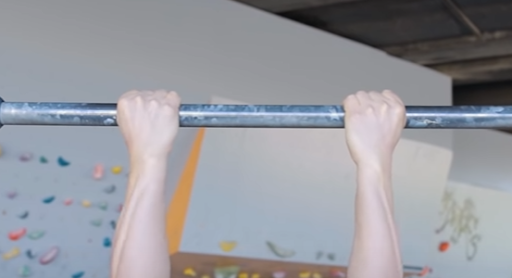
Source: FitnessFAQs
The underhand grip helps you perform the ever-popular, bicep-builder, chin-ups. To perform the grip, hold the bar with your palms facing backward by twisting your forearm inwards (supination).
This grip requires shoulder flexion, shoulder external rotation, and forearm supination. As a result, people who lack mobility tend to experience elbow pain AKA golfer’s elbow.
Don’t worry, you can always address your weaknesses so you can firm chin-ups with lower risks: Say No to Golfer’s Elbow
Overhand (pronated) grip

Source: FitnessFAQs
This grip is used to perform the standard pull-ups. The overhand grip is done with your palms facing forward. People are usually mobile and flexible enough to perform this hand positioning and no longer need to have the mobility required from supination or shoulder external rotation.
This grip offers the best transferability to muscle-ups. It’s also more back dominant which is why people struggle more with it than chin-ups. There’s less assistance from the biceps with this grip.
Neutral grip
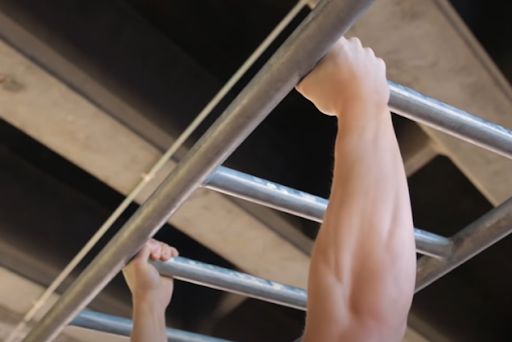
Source: FitnessFAQs
To perform the neutral grip, find a bar where you can keep your palms facing each other. The benefit of this grip is that it can minimize elbow joint pain while still placing muscle activation on your biceps and forearms. It’s a good alternative for chin-ups while minimizing elbow strain.
What are the benefits of doing pull-ups?
Pull-ups are a great way to work your back and biceps. They’re also fantastic for building grip strength.
Many people fail to perform a pull-up correctly. Although it’s a basic exercise, there actually more complex than what we can see.
There are countless benefits to doing pull-ups, but here are just a few:
- Increased muscle mass – Pull-ups help build both your biceps and latissimus dorsi (back) muscles. They’re known as a compound exercise, meaning they work for multiple muscle groups at once. This makes them extremely effective for increasing both strength and size.
- Improved posture – By strengthening your back muscles, pull-ups can help to improve your posture. This is because weak back muscles can lead to slouching and rounded shoulders.
- Greater grip strength – As mentioned above, using a different grip can target different muscle groups. For example, using a pull-up grip strengthens your forearms. This is highly beneficial for athletes who need a strong grip, such as rock climbers or CrossFitters.
- Reduced risk of injury – Stronger muscles helps to protect your joints and tendons from injury. This is especially important for active people who participate in sports that put stress on the upper body, such as weightlifting or football.
- Improved core strength– Pull-ups are a great way to build a solid core. While it’s not that obvious, your core is the most active muscle when performing a pull-up.
- Increased coordination and balance – Doing pull-ups requires a great deal of coordination and balance. You’re using your arms and legs to lift your entire body weight. As a result, pull-ups can help to improve your coordination and balance.
Some of the other benefits worth mentioning are that pull-ups can help to improve your mental health, increase your lifespan, and make you happier. It’s also quite an achievement working your way towards this skill.
What is the easiest pull-up grip to use
Some people find wide neutral or the hammer grip the most manageable grip when performing chin-ups. In comparison, others find underhand or the supinated the easiest.
The neutral grip is more often used since it is the safest grip since it doesn’t require much upper body mobility compared to an overhead or underhand grip.
But people tend to experience the chin-up grip to be the easiest anecdotally because of the large bicep assistance that comes with the grip. However, as mentioned earlier, performing chin-ups are susceptible to elbow pain if not done correctly.
What is the best pull-up grip for the biceps?
There are three main types of biceps pulling motion in pull-ups: the underhand pull-up, parallel-grip pullup, and narrow-grip pullup. These three types of biceps curl work the biceps differently.
Underhand Pull-Up
The underhand pull-up variation also goes by the name “chin-up.” The underhand pull-up requires you to grip the bar with an underhand grip—palms facing you—and then pull yourself up until your chin is over the bar. This type of bicep pull-up is the most efficient at targeting the biceps.
Narrow-Grip Pullup
The close-grip pull-up or the narrow-grip pull-up is performed with a narrower grip than the regular underhand pull-up. Therefore, the close-grip pull-up emphasizes the lats and more on the biceps due to the increase in elbow flexion.
You must hold the bar with your hands close together—usually shoulder-width apart—and then pull yourself up until your chin is over the bar. It specifically targets the arm and stays away from the back.
Parallel/neutral-Grip Pullup
In parallel-grip pull-up variation, your palms face each other. This grip style can be done using a parallel bar at the gym or using parallel grips on certain types of home pullup bars.
Like the narrow-grip pullup, the parallel grip helps shift the back to the arms. You can perform narrow-grip pullups with a parallel grip style to further target the biceps and forearms.
What is the best pull-up grip for triceps?
The tricep is a bigger muscle group than the bicep which is why it’s usually what makes our arms appear bigger. While pull-up variations are excellent for developing the upper body, it’s not ideal for targeting the tricep muscle group.
The triceps act as an elbow extensor. It does assist when you perform the negative portion of the exercise but does not actively engage in the full motion.
Dips, push-ups, ring dips, and other pushing exercises are far better options for developing your tricep muscles.
Which pull-up grip is best for the back?
The pronated or the overhand grip is POTENTIALLY the best grip for targeting the back muscles. The difference between the regular pull-up’s latissimus dorsi activation is not significant compared to any other grip. HOWEVER, it provides less limitation on other muscle groups for you to perform more reps and sets safely.
Why is the pronated grip effective?
Because it puts the biceps into a disadvantageous position, they can’t assist much in the workout. This means that if you have weak biceps, you won’t be limited by your arms to complete the pulling motion.
Most of the tension is placed on the back muscles to perform the movement. However, your hand placement isn’t the only thing to consider. For example, the width of your grip has a big impact on whether or not you have a wide back with pull-ups.
Limit the risk of elbow pain
With the pronated grip, you will also not be limited with your forearm supination mobility or your ability to turn your forearms inward. The grip places less tension on your elbow joints so you can continue performing more reps without this limitation.
Most people are more likely flexible enough to hold a pronated grip on a bar compared to holding a supinated grip.
Can I do lat-pulldowns instead of pull-ups?
The lat pulldowns (mostly the seated lat pulldown) are considered the pull-up counterpart in the weightlifting world. While there are similarities in terms of movement patterns at first glance, research shows that there’s less transferability than what meets the eye.
Yes, the lat pulldown can target the lats that can supplement in learning the pull-up BUT the transferability ends. The pull-up is a complex movement that involves the whole body which lat pulldowns cannot replicate.
A better option can be the kneeling lat pull-down as a 2018 research study suggests.
When to use the false grip?
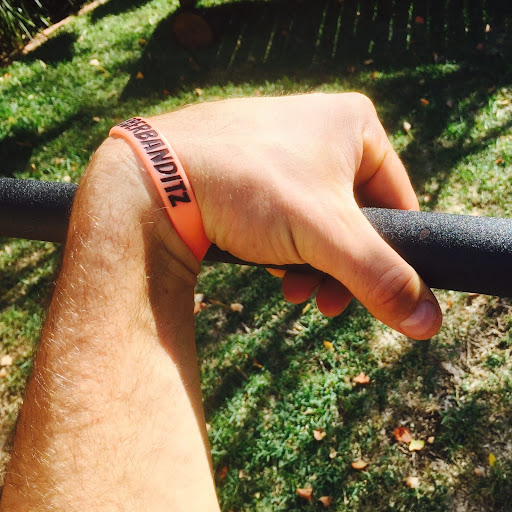
Souce: RubberBanditz
Do you want to learn muscle-up? Then the false grip is for you.
To perform the false grip, you need to hold the bar deeper so that your whole palm is wrapped around the whole bar or rings. This allows you to transition from the pull-up phase to the dip phase of a strict muscle-up.
This grip is not necessary to learn if you’re not interested in learning muscle-ups, but it can be handy in improving your forearm strength.
What grip should I use for One-arm chins/pulls?
Specific Adaptations to Imposed Demands or SAID principle governs this concern. Use a specific grip you want to learn your single-arm pulling work on. For example, if you want to learn with a pronated grip, train with a pronated grip.
This will be highly based on preference as there’s no specific advantage for each grip. What matters most is that you continue learning the skill with one grip to stay consistent and gain progress.
Where should I do my pull-ups? Bar or rings?
This topic deserves a separate article on its own which you can read here: Straight Bar Pull-ups vs Gymnastic Ring Pull-ups
But to give you a summary, beginners can benefit most from starting out in a bar. Stable bar pull-ups let you exert maximum effort without requiring you to stabilize the surface.
Pull-ups on rings are a bit more challenging since you have to keep your whole body stable to perform the exercise. This makes the exercise more challenging and the grip isn’t also beginner friendly. However, since the rings are free to move, they can help you alleviate any unnecessary stress on your joints.
Both offer amazing benefits. Choose which one offers the most for your goals or whichever is accessible to you at the moment.
Conclusion
The pull-up is an excellent exercise for many reasons. First, it’s a compound movement, meaning it works for multiple joints and muscle groups simultaneously. Second, it’s an upper-body exercise that specifically targets the back muscles. Third, it balances out the strength and muscle gains you do from pushing movement patterns.
With different fitness levels, areas that you want to work out with, and specific muscle group focus, there are many kinds of pull-ups that you can do. Avoid pull-up mistakes and lessen the risk of injury while maximizing results.
Utilize the different grips to get the most out of your pull-up workout routine. THERE’S NO SINGLE BEST GRIP. Each offers it’s own benefits and can be a choice of preference.
Feel free to share this article with your friends looking to improve their pull-up game!
If you’re not yet confident with your pull-ups, then take a step back and know what your body is capable of. Begin with an assessment like what we have below so you can get a personalized calisthenics training program that can help you build the basics for mastering the pull-up!

